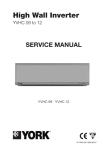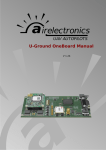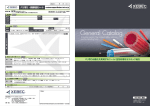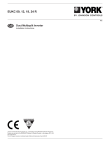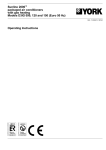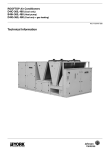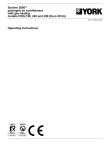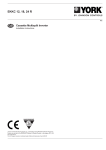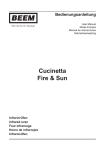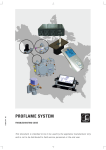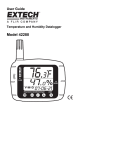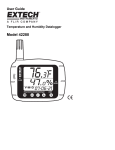Download York DPC-1 Operating instructions
Transcript
DPC-1 Ref: N-40130 0404M E Termostato digital programable con comunicación Instrucciones de Manejo y mantenimiento ○ ○ ○ ○ ○ ○ ○ ○ ○ ○ ○ ○ ○ ○ ○ ○ ○ ○ ○ ○ ○ ○ ○ ○ ○ ○ ○ ○ ○ ○ ○ ○ ○ ○ ○ ○ ○ 3-8 GB Programmable digital thermostat with communication Operating and Maintenance Instructions F ○ ○ ○ ○ ○ ○ ○ ○ ○ ○ ○ ○ ○ ○ ○ ○ ○ ○ ○ ○ ○ ○ ○ ○ ○ ○ ○ ○ ○ ○ ○ ○ ○ 9 - 14 ○ ○ ○ ○ ○ ○ ○ ○ ○ ○ ○ ○ ○ ○ ○ ○ ○ ○ ○ ○ ○ ○ ○ ○ ○ ○ ○ ○ ○ ○ ○ ○ ○ ○ ○ ○ ○ ○ ○ ○ ○ ○ ○ ○ ○ ○ ○ ○ ○ ○ ○ ○ ○ ○ ○ ○ ○ ○ ○ ○ ○ 15 - 20 ○ ○ ○ ○ ○ ○ ○ ○ ○ ○ ○ ○ ○ ○ ○ ○ ○ ○ ○ ○ ○ ○ 21 - 26 Termostato digitale programmabile con comunicazione Istruzioni per l'uso e la Manutenzione D ○ Termóstato digital programável com comunicação Instruções de Utilização e Manutenção I ○ Thermostat digital programmable avec communication Instructions d'Utilisation et de Maintenance P ○ ○ ○ ○ ○ ○ ○ ○ ○ ○ ○ ○ ○ ○ ○ ○ ○ ○ ○ ○ ○ ○ ○ ○ ○ ○ ○ ○ 27 - 32 Programmierbarer Digital-Thermostat mit Kommunikationsmöglichkeit Hinweise zu Bedienung und Wartung ○ ○ ○ ○ ○ ○ ○ ○ ○ ○ ○ ○ ○ ○ ○ ○ ○ ○ ○ ○ ○ ○ ○ ○ ○ ○ ○ ○ ○ ○ ○ ○ ○ ○ ○ ○ ○ ○ 33 - 38 NL Programmeerbare digitale thermostaat met communicatieverbinding Bedienings- en onderhoudsinstructies N ○ ○ ○ ○ ○ ○ ○ ○ ○ ○ ○ ○ ○ ○ ○ ○ ○ ○ ○ ○ ○ ○ ○ ○ ○ ○ ○ ○ ○ ○ ○ ○ ○ ○ ○ ○ ○ ○ ○ ○ ○ ○ ○ ○ ○ ○ ○ ○ ○ ○ 39 - 44 Programmerbar digital termostat med kommunikasjon Betjenings- og vedlikeholdsinstrukser ○ ○ ○ ○ ○ ○ ○ ○ ○ ○ ○ ○ ○ ○ ○ ○ ○ ○ ○ ○ ○ ○ ○ ○ ○ ○ 45 - 50 E U R O V E N T ER-0028/1991 ISO 14001 ISO 9001 CERTIFIED PERFORMANCE CGM-97/013 Clima Roca York S.L. participa en el Programa de Certificación EUROVENT. Los productos se corresponden con los relacionados en el Directorio EUROVENT de Productos Certificados, en el programa AC1, AC2 y AC3. Clima Roca York S.L. partecipa al Programma di Certificazione EUROVENT. I prodotti interessati figurano nella Guida EUROVENT dei Prodotti Certificati, nel programma AC1, AC2 e AC3. Clima Roca York S.L. is participating in the EUROVENT Certification Program. Products are as listed in the EUROVENT Directory of Certified Products, in the program AC1, AC2 and AC3. Clima Roca York, S.L. ist am Zertifikationsprogramm EUROVENT beteiligt. Die entsprechend gekennzeichneten Produkte sind im EUROVENT-Jahrbuch im Programm AC1, AC2 und AC3 enthalten. Clima Roca York S.L. participe au Programme de Certification EUROVENT. Les produits figurent dans l'Annuaire EUROVENT des Produits Certifiés, dans le programme AC1, AC2 et AC3. Clima Roca York, S.L. neemt deel aan het EUROVENT-certificatieprogramma. De produkten zijn opgenomen in het EUROVENT-jaarboek van de gecertificeerde produkten, in de programma AC1, AC2 en AC3. Clima Roca York S.L. participa no Programa de Certificação EUROVENT. Os produtos correspondem aos referidos no Directório EUROVENT de Produtos Certificados, no programa AC1, AC2 e AC3. Clima Roca York, S.L. deltar i EUROVENT sertifiseringsprogram. Produktene er oppført i EUROVENT's katalog over sertifiserte produkt, i kategorie AC1, AC2 og AC3. 1 2 The compressor should not be started until a minimum of eight hours later. This is done to evaporate any refrigerant in liquid form that may be been mixed in with the oil in the compressor. Operating instructions Controls and indicators 1.2.3.4.5.- Program mode selection. Operating mode selection. Day/night/unoccupied selection. Fan speed selection Outdoor temperature reading Caution: POWER SUPPLY ON AUTO PROG Recommendations for best operation AUTO °C 4 0h 2 4 6 - Turn the air conditioning on before the room gets warm. Any heat accumulated on furniture, walls, etc., makes the unit take longer to reach the desired temperature. - It is advisable to inspect and service your equipment whenever necessary; this avoids damage and ensures long service life of your air conditioner. 8 10 12 14 16 18 20 22 24 SET POINT TEMPERATURE SELECTION PROG Connection: To preheat the system, the electrical heater should be tourned on at least 8 hours prior to starting the air conditioning unit. Leave power supply on, unless the air conditioner is not to be used during long periods of time. MODE Ambient thermostat DPC-1 1 2 3 Keyboard locked These thermostats are designed to give precise ambient temperature control and graphic information with regard to heat pump operation. In compliance with the differential between the programmed and ambient temperatures, it varies the on/off cycles. The liquid crystal display (LCD) normally shows the ambient temperature, the operating mode and whether the cooling or heating system is in operation. It allows selecting different temperature set points for cooling and heating, as well as their indication in °C or °F. The fan can be set to operate in a continuous or automatic mode, stopping and operating jointly with the compressor.. The controls are located beneath a cover. Failure or incident Outdoor temperature Operation and start-up Dirty filters Start-up is carried out by means of the thermostat controls. 4 5 Fig. 1 Cooling Heating Timer active Unoccupied Temperature setting Economy (night) Room temperature Comfort (day) Air conditioning mode Fan OFF EMERG HEAT COOL AUTO PROG Dead battery °F AUTO °C 1 2 3 4 5 6 7 Day of the week 0h 2 4 6 8 10 12 14 16 18 20 22 24 1.- MODE Time Pressing this button sets the heat pump operating mode. When pressed alternatively, the LCD screen shows the following operating modes: Time schedule profile Fig. 2 General information Important warning Automatic temperature start-up and regulation is carried out by means of an ambient thermostat. Locate the thermostat at approximately 1.5 m. above floor level, where no obstacle can avoid measuring the real temperature of the room. The thermostat should be placed on a wall not exposed to direct sunlight; otherwise, temperatures would not be real and operation would be poor. Before starting up, turn the general switch on so as to supply power to the electrical heater of the compressor crankcase. GB COOL mode. Controls the system in cooling HEAT mode. Controls the system in heating AUTO Controls the system in either the cooling or heating modes, as needed. AUTO PROG. Controls the system in cooling or heating, depending upon the time schedule profile selected. (If microswitch pin 2 is set to OFF, this option does not appear. 9 EMERG HEAT. Controls the system in emergency heating mode (operates only if an electric heater, optional accessory, is installed). OFF. Turns the air conditioning system off or could be use to set fan only mode. a) Cooling Press MODE button alternatively until appears on the the cool symbol screen (along with the word COOL) (Fig. 3). AMBIENT TEMPERATURE MODE SELECTED COOL AUTO °C 5 c) Automatic Press the MODE button alternatively until the heating and cooling symbols appear on the screen (along with the word AUTO) (Fig. 5). Select a temperature setting for the cooling mode and another for the heating mode as desribed in paragraphs a) and b). In this operating mode, the COOL temperature setting should be least 1°C above the HEAT temperature setting, which is the minimum differential allowed by the thermostat. Press the MODE button repeatedly displays the cooling or heating set points. After 5 seconds the ambient temperature is displayed (Fig. 5). COOLING SYMBOL Fig. 3 MODE SELECTED HEATING SYMBOL Once the operating mode is set, select the temperature setting by pressing button or so as to set a higher or lower temperature. The temperature seting appears along with a small symbol that represents a thermometer, and remains on screen for 5 seconds. When the temperature setting disappears, the ambient temperature appears once again. After a few minutes, the cooling system will begin to operate and the cooling symbol on screen will start to flash. b) Heating Press the MODE button alternatively until the heating symbol appears on the screen (along with the word HEAT) (Fig. 4). AMBIENT TEMPERATURE MODE SELECTED HEAT AUTO °C 5 For correct operation of this mode, first you must set the time on the clock and select the number of the day of the week. Then select the desired time schedule profile for the different days of the week. See the section on Programming Menu. Select a temperature setting for the cooling mode and another for the heating mode, in accordance with the programming menu. (Fig. 6) In this mode you must define the temperature set point for day, night and unoccupied conditions. After a few minutes, the system will start, switching automatically to either the heat or cool mode and keeping the ambient temperature between the selected set points and in compliance with the time schedule profile selected. ambient temperature appears once again. After a few minutes, the heating system will begin to operate and the heating symbol on screen will start to flash. AMBIENT TEMPERATURE AUTO AUTO °C 1 e) Emergency heat Press the MODE button alternatively until the words EMERG HEAT are displayed, along with the heating symbol. After a few minutes, the emergency heat will begin to operate and the heating symbol will flash on the screen. In this operating mode, the compressor is always inoperative and the auxiliary and emergency heaters (optional accessories), if installed, are used for heating. This operating mode can be used for heating when there is any problem with the compressor (Fig. 7). COOLING SYMBOL Fig. 5 After a few minutes, the system will beging to operate, switching automatically between the heating and cooling modes so as to keep the ambient temperature between the two settings. When either the heating or cooling mode are in operation, the corresponding symbol starts to flash. AMBIENT TEMPERATURE MODE SELECTED EMERG HEAT d) Automatic programming If this option is not selected, it will not appear (can be selected by setting micro-switch No. 2 to ON). Press the MODE button alternatively until the heating and cooling symbols are displayed (along with the words AUTO PROG). The selected time schedule profile is also displayed (Fig. 6). AUTO °C 5 HEATING SYMBOL Fig. 7 HEATING SYMBOL Fig. 4 Once the operating mode is set, select the temperature setting by pressing butor so as to set a higher or ton lower temperature. The temperature setting appears along with a small symbol that represents a thermometer, and remains on screen for 5 seconds. When the temperature setting disappears, the 10 AUTO PROG AUTO °C 1 DAY OF THE WEEK 0h 2 4 6 8 10 12 14 16 18 20 22 24 TIME TIME SHCEDULE PROFILE COOLING SYMBOL Fig. 6 GB AMBIENT TEMPERATURE HEATING SYMBOL MODE SELECTED COMFORT (DAY) COMFORT (DAY) ECONOMY (NIGHT) f) Off Press the MODE button alternatively until OFF appears on the screen. The unit is turned off and the word OFF, the ambient temperature, the day of the week and the time are displayed permanently on the thermostat display (Fig. 8). ating modes). Once the thermostat is installed, the symbol is displayed, indicating that the temperature settings selected is for the day period (comfort). Pressing the button displays the symbol, indicating that the temperature settings is for the night period. Whenever this button is pressed the temperature settings are alternated, in both day and night periods. OFF °C 3 DISPLAY WHEN THE UNIT IS FULLY OFF Fig. 8 g) Ventilation only This operating mode is available in the OFF mode by pressing the button, which selects the fan speed. OFF °C 3 h) °C/°F scale To change the temperature degree scale, press the buttons simultaneously. 2.- Fan When the button is pressed, the Adjust mode is entered for 5 seconds. The fan symbol is flashing. Pressing de button, you adjust the fan speeds ( ) and the fan regulation: automatic (AUTO) or in continuous operation (AUTO disappear). When the fan is set automatic (AUTO), it will operate automatically the fan in acordance with the compressor or heating sources. Example: - AUTO Automatic high speed Fixed low speed - You can configurate the thermostat with only one speed (micro-switch nº 6 to ON) 3.- Day/night selection By pressing the button you can select different temperature settings for the day and night periods (in each one of the oper- 4.- Unoccupied selection Pressing the button for over 1 second selects the unoccupied temperature setting. Pressing the or button selects the desired temperature. If the MODE button is pressed in AUTO mode, the cool or heat set points in unoccupied mode are displayed alternatively. If while in the adjust mode the PROG button is pressed, the temperature setting is replaced by number 0, indicating the number of days the unoccupied mode should last. The and buttons increase and decrease the number of unoccupied days. If left at 0, this mode is maintained indefinitely; but if a number of days beyond 0 is programmed, the icon flashes throughout the unoccupied period, indicating its temporary nature. Once the unoccupied period has concluded, the thermostat will switch over to the day period (confort), except when the air conditioning mode is AUTO PROG, in which case the occupation mode will be the mode indicated by the time schedule profile. To exit the unoccupied option, just press the button. 5.- Reading outdoor temperature Pressing the button displays the outdoor temperature for 5 seconds. 6.- Ambient temperature remote sensor option The DPC-1 thermostat is designed to accept a remote sensor for controlling the ambient temperature of a room other than the one the DPC-1 thermostat is located in. The remote sensor is to be connected to the inner connecting strip of the thermostat, terminals RS1-RS2. 7.- Graphic information The display provides constant information on: ambient temperature, operating mode, day/night period and fan operation. To have acces to information on the temperature set points press, just once, one of the temperature setting buttons. This will give us, on screen and for 5 seconds, the temperature set point established for the operating mode that is visible on screen at that moment. played on screen: Clock setting (day of the week, hours and minutes). Fan setting. Selection of schedule profiles. A schedule profile accepts only Comfort and Economy (Day and Night) periods. If pin 2 of the microswitch is set to OFF, this option is not displayed. Select temperature setting for heating and cooling mode in Comfort (Day) period. Select temperature setting for heating or cooling mode in Economy (Night) Mode. Select temperature setting for heating and cooling in Unoccupied Mode. The active or selectable option will flash. The initial option is setting the clock. 0h 2 4 6 8 10 12 14 16 18 20 22 24 0h 2 4 6 8 10 12 14 16 18 20 22 24 The active buttons are: Allow selecting the active option. Allow changing the selection. Selects the active option. Exits the Programming menu , switching the thermostat in Normal Mode. The display will come back to Normal mode if no button have been pushed during 30 seconds. 1- Clock setting Allows setting the day of the week, hour and minutes. 1 Programming menu If the PROG button is pressed in Normal Mode, only the symbols of the different parameters that can be programmed are dis- GB 11 2- Fan setting Allows programming fan status in the different occupation periods (Day, Night or Unoccupied). Periods and fan status are displayed. 4- Selection of time schedule profiles There are five predetermined profiles (P1 to P5), and an additional profile that can be programmed by the user. Upon selecting the option on the programming menu, all days of the week are displayed on screen, with day 1 of the week (Monday) flashing, the program presently memorized for this day, flashing and the corresponding profile. 0h 2 4 6 8 10 12 14 16 18 20 22 24 Micro-switches for configuration of the thermostat The thermostat has a configuration system through micro-switches located in rear of the front panel. For standard thermostat operation, these pins are factory-set to OFF. Nevertheless, these settings can be change in accordance to user needs. The functions of each one are described below. AUTO "A" REAR OF FRONT PANEL 1 2 3 4 5 6 7 0h 2 6 8 10 12 14 16 18 20 22 24 R B G Y Y2 W O/B X1 X2 RS2 RS1 DETAIL "A" ON The predetermined profiles are 5: 1. P1, always economy (night), 0h 2 4 6 8 1 2 3 4 5 6 MICRO-SWITCHES SW1 10 12 14 16 18 20 22 24 2. P2, always comfort (day), 0h 2 4 6 8 10 12 14 16 18 20 22 24 3. P3, with comfort cycle of 7-23 hours, the rest economy (night), 0h 2 4 6 8 10 12 14 16 18 20 22 24 4. P4, with two comfort cycles of 7-9 and 18-23 hours, the rest economy (night), 0h 2 4 6 8 10 12 14 16 18 20 22 24 5. P5, with three comfort cycles of 7-9, 1315 and 18-23 hours, the rest economy (night), °C 0h 2 4 6 8 10 12 14 16 18 20 22 24 profile is displayed, the When the user text appears in clock digits to indicate that the key with this denomination is ready to program the profile. Pressing the PROG key while displaying the user profile during Selection of time schedule profiles accesses the configuration of this profile. 12 RS3 THERMOSTAT BASE AL 3- Day, Night or Unoccupied temperatures setting There is a total of six programmable temperature settings that correspond to the heat and cool modes of the three occupation periodes (Day, Night and Unoccupied). These settings must follow an order from cooler (a) to warmer (f). a. Cool set point in Unoccupied mode. b. Cool set point in Night mode. c. Cool set point in Day mode. d. Heat set point in Day mode. e. Heat set point in Night mode. f. Heat set point in Unoccupied mode. The thermostat will never allow differencial of less than 1°C (2°F) between each setting. If when moving one of the setting we come to less than 1°C (2°F) from the next one, it will be “dragged” so as to avoid the unsuitability of settings. When this occurs, the thermostat will show it by flashing the period icon of the setting being dragged. 4 GB Micro-switches SW1 allow the configuration of the following parameters: - Pin 1: Lock keyboard. In OFF the keyboard is not locked. In ON the keyboard is locked and the locked keyboard symbol ( ) is displayed. The buttons that remain active are: , and (outdoor temperature reading). - Pin 2: AUTO PROG mode activated. Defines whether the automatic air conditioning mode with time schedule programming (time schedule profiles) can be activated. OFF indicates the AUTO PROG mode is deactivated, and ON indicates the AUTO PROG mode can be selected. - Pin 3: O/B signal: Set to OFF, heat is generated when the O/B (24 VAC) signal is active, and cool when inactive. Set to ON, cool is generated when the O/B (24 VAC) signal is active, and heat when inactive. - Pin 4: 2 minutes/4 minutes. Defines the time between the end of one phase and when it can be active again. OFF indicates 2 minutes, and ON, 4 minutes. - Pin 5: Multi-stage. Defines single-stage (one stage can be activated only) or multi- stage (more than one can be activated). OFF indicates single-stage and ON, multistage. - Pin 6: Single-speed fan. Defines whether the fan can operate at one or three speeds. OFF indicates 3 speeds and ON, 1 speed. In single-speed, the wind icons are not displayed. Alarms The alarm codes are displayed at the bottom left of the screen, overlapping hour and minutes. The alarm codes are as follows: - 0-90, machine error codes. - 91, temperature origin selected is invalid. - 92, indoor temperature sensor not calibrated. - 93, communication alarm. - 94, alarm pin. When an alarm is generated, the wrench symbol is displayed. If the error is machine or communication, this symbol flashes; if not, it remains static. Filters. If the dirty filters symbol is displayed flashing, the filters need to be changed. Dead battery. The dead battery symbol indicates the batteries are dead, and these should be changed. System configuration is not lost when changing the batteries. Only day and time are lost. Table of lockouts (Red LED) Code Designation 11 / 21 / 31 Compressor discharge temperature surpased or short circuited probe 12 / 22 / 32 High Pressure switch, outdoor fan overload or compressor motor protection module 13 / 23 / 33 Low Pressure switch. 14 / 24 / 34 Indoor fan thermal switch 15 / 25 / 35 Repeated start-ups in cool, or suction temperature < -25°C 41 Gas 1 or electrical heater 1 42 Gas 2 or electrical heater 2 43 Electrical heater 3 44 Electrical heater 4 Installation instructions It is recommended that the installation be carried out by a qualified personal. Location To assure adequate operation, this thermostat should be installed on an indoor wall, in a frequently occupied area of the building. Furthermore, it should be at at least 50 cms. from any outside wall, and at approximately 1.5 m. above floor level, in an area with freely circulating air at average temperature. The following locations should be avoided: - Behind doors or in corners where freely circulating air is unavailable. - Where direct sunlight or radiant heat generated by other appliances may alter the control operation. - On an outside wall. - Next to or in line with air conditioning discharge grids, stairwells or doors leading outdoors. - Where operation can be affected by steam or water pipes, or hot air chimneys in adjacent areas or any other unheated/ uncooled area behind the thermostat. - Where operation can be affected by the supply air of any adjacent unit. - Near sources of electrical interference, such as arching relay contacts. Basic elements This thermostat comprises three parts: - Hinged front cover. - Front panel. This element contains the operating and control keys, as well as the printed circuit. Fastened to the base by means of a plastic tab. - The base. This box allows fastening the thermostat to the wall, and contains the electrical connecting strips. 46 Smoke detector, fire thermostat or air discharge temperature probe (rooftop only) > 80° C 91 Selected probe not valid or short circuited probe 92 Thermostat internal probe not calibrate 93 No communication between the thermostat and the main PCB (YKlon) 94 Lockout from external input FRONT COVER FRONT PANEL BASE Thermostat installation To fasten the thermostat to the wall, open the front panel and uncover the base of the thermostat. Proceed as shown in the following illustration: 1- Press the plastic tab at the base of the thermostat, as indicated by arrow A. 2- While pressing A, raise the front panel as indicated by arrow B. FRONT PANEL FRONT COVER A BASE OF THERMOSTAT AUTO °C 4 Economizer or hot water coil ALKALINE BATTERIES B AUTO 45 ELECTRIC CONNECTING STRIP 0h 2 4 6 8 10 12 14 16 18 20 22 24 The fastening holes found at the base coincide with the standard electric boxes on the market. In the case the connecting cable does not come from the electric box, the thermostat must be fastened to the wall with the anchors and screws supplied. Keep in mind that the rectangular hole in the centre of the base is to house the electric connecting cable. GB 13 Standard electric connections, thermostat DPC-1 (for thermostat with communication) Once the base is fastened to the wall, wire the thermostat as shown in the following illustration: Caution A shielded 10 x 0.22 mm² cable, with a maximum length of 100 m., should be used between the thermostat and the control board. Connections to be carried out are R, B and X1. (The other 7 wires are necessary to connect G, Y, Y2, O/B and W if you wish to use a thermostat with relays) To connect the remote sensor use shielded 2 x 0.5 mm2 cable with a maximum length of 100 m. between the thermostat and the sensor. The connections to be carried out are RS1 and RS2. For correct operation of the thermostat, it is indispensable to have made electric wiring properly, and have inserted the two AAA 1.5 V alkaline batteries at the rear of the front panel, as shown below: SHIELDED CABLE 2x 0,5 mm2 cable (MAXIMUM LENGTH 100 m) REAR OF FRONT PANEL SHIELDED 10x 0.22mm2 CABLE (MAXIMUM LENGTH 100 m) YELLOW RED B AAA 1.5 V ALKALINE BATTERIES R G Y Y2 W O/B X1 X2 RS1 RS3 RS2 AL WHITE BASE OF THERMOSTAT 14 GB R G B Y Y2 W O/B X1 X2 RS2 RS1 AL Data and measurements are subject to change without prior notice. RS3 BASE OF THERMOSTAT REMOTE PROBE (OPTIONAL) 51 DECLARACION CE DE CONFORMIDAD SOBRE MAQUINAS FABRICANTE: CLIMA ROCA YORK, S.L. DIRECCIÓN: Paseo Espronceda, 278, 08204 SABADELL Certificamos que el equipo descrito, es conforme a las exigencias básicas de las directivas Europeas que le son aplicables, incluidas las modificaciones de las mismas y las correspondientes transposiciones a la ley nacional. APLICACIÓN DE LA MÁQUINA: TIPO: AIRE ACONDICIONADO/REFRIGERACION DPC-1 ......... DIRECTIVAS DE LA CE APLICADAS: 98/37/CEE, 73/23/CEE, 89/336/CEE NORMAS ARMONIZADAS APLICADAS: EN60204-1, EN292-1, EN292-2, EN563, EN294, EN953, EN55014, EN60555-2, EN50082-1 NORMAS INTERNACIONALES Y ESPECIFICACIONES TÉCNICAS APLICADAS: LUGAR: EN ISO 9001, EN ISO 14001 Sabadell, (España) FIRMA: ROMÁN LARRODA JEFE CONTROL DE CALIDAD DECLARATION OF COMPLIANCE ON MACHINERY MANUFACTURER: CLIMA ROCA YORK, S.L. ADDRESSE: Paseo Espronceda, 278, 08.204 SABADELL We hereby certify that the mentioned equipment complies with the essential requirements of the European directives applicable, including their modifications and the corresponding transpositions from the national law. APPLICATION OF THE MACHINE: AIR CONDITIONER/COOLING TYPE: .DPC-1 ........ EEC DIRECTIVES APPLIED: 98/37/EEC, 73/23/EEC, 89/336/EEC APPLIED HARMONIZED STANDARDS: EN60204-1, EN292-1, EN292-2, EN563, EN294, EN953, EN55014, EN60555-2, EN50082-1 APPLIED INTERNATIONAL TECHNICAL STANDARDS AND SPECIFICATIONS: PLACE: Sabadell, (España) EN ISO 9001, EN ISO 14001 SIGNATURES: ROMÁN LARRODA QUALITY CONTROL MANAGER 52










